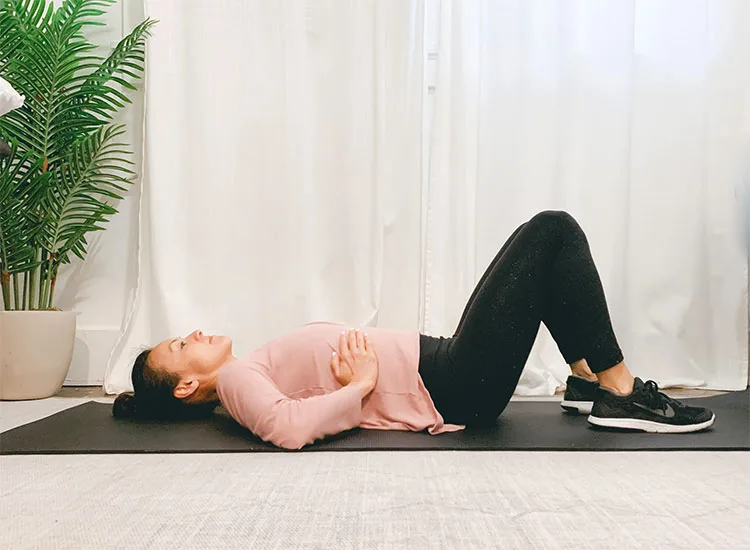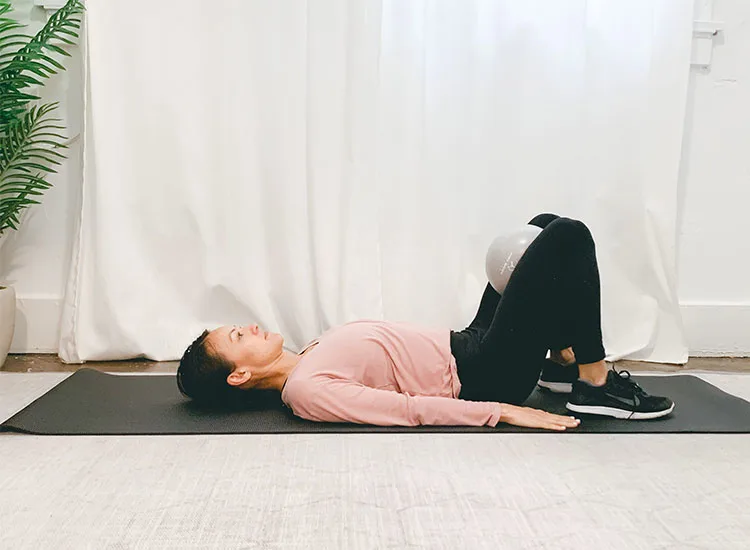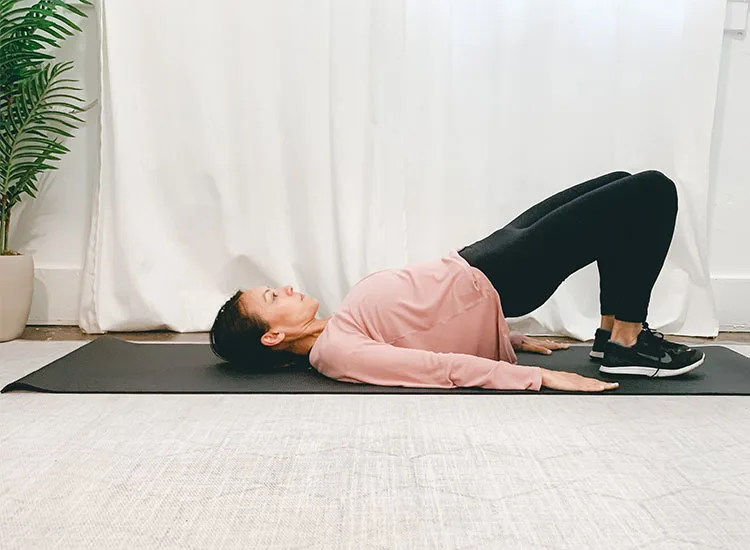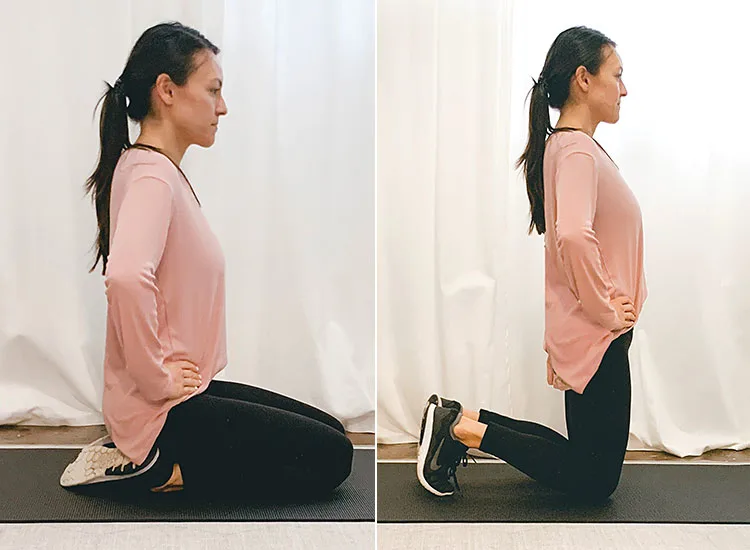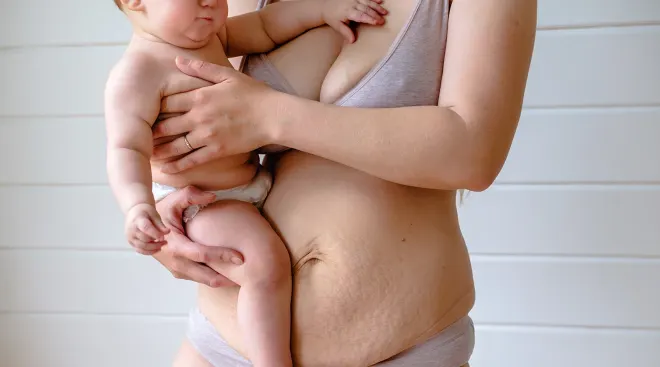5 Exercises to Strengthen Your Core After C-Section
Over 30 percent of births are via cesarean section in the United States. After the initial healing period, many moms may want to know how to safely return to exercise and regain their core strength. Your core muscles undergo significant changes during pregnancy, as the abdominal and pelvic floor muscles lengthen to accommodate your growing baby, and following a cesarean birth, which involves making an incision through several layers of skin and fascia in the abdominal wall. Good news, though: The abdominal muscles are not typically “cut” during ac-section and are instead gently separated in the midline to access the uterus. So with a gradual return to exercise and some focused core work, you can absolutely regain core strength and function. Read on for the best core and ab exercises to do after a c-section.
The first step is to allow time for your body to heal. The first few weeks after a cesarean birth should be focused on rest, healing, hydration and feeding and bonding with your new baby.
Within the first day after surgery, pelvic health physical therapists like myself encourage moms to start getting out of bed to walk every day. This helps encourage upright standing and promotes healing and blood flow to your recovering core and pelvic floor. When getting in and out of bed, make sure to roll over onto your side and use your arms to help you push up or lower down, to protect your healing abdominals. You can continue shorts walks daily and gradually increase the length of walks as you feel able, scaling back if pain or bleeding increase.
You may have heard that women are cleared to exercise at their six-week postpartum check up, but this isn’t always the case. If you do receive the “all clear,” it means that there is no sign of a condition or issue requiring medical intervention by the physician. It does not mean that your tissues are done healing or that they are ready for high impact. If you’re experiencing urinary leakage, pain, pelvic pressure or heaviness, or abdominal doming or coning, you should check in with a pelvic floor physical therapist. They can assess your pelvic floor and abdominal wall, help with pain, prolapse or leakage and guide you on an individualized plan for returning to exercise.
After six to eight weeks postpartum, it’s generally safe to return to low-intensity activities like walking and some gentle core and pelvic floor strengthening exercises.
The focus should be on rebuilding your core and pelvic floor muscles during the first 12 weeks after birth before returning to higher impact activity such as running, weightlifting or high-intensity interval training. Higher-intensity activities put a greater demand on the muscles of the pelvic floor and abdomen. These activities are typically not appropriate until at least three months postpartum and in many cases up to six months postpartum.
The initial and most important piece of exercise after c-section is to start retraining and restrengthening your core. These activities will bring good blood flow to the pelvic region and start working those pelvic floor and abdominal muscles again without adding unwanted strain.
We often think of the “core” as just your abdominal wall, but it’s really a group of muscles that include your abdominal, pelvic floor and low back muscles as well as your respiratory diaphragm to give you core support from all sides. Starting with the following core exercises will help rebuild your foundation and strength after 10 months of pregnancy and childbirth and get you back to feeling strong.
Diaphragmatic breathing
Diaphragmatic breathing is the first exercise to start reconnecting with your core after c-section. What does breathing have to do with your core? Answer: everything! Holding your breath may keep your abdominal and pelvic floor muscles tight and tense and prevent an optimal pelvic floor muscle contraction. Also, diaphragmatic breathing helps expand tight tissues around your c-section scar to minimize scar restriction.
Although this can be performed in any position, including lying down, sitting (while feeding your baby is a convenient time!) or standing, I encourage moms to start lying down.
Instructions:
- Lie flat on your back with knees bent and feet resting on the floor.
- Rest one hand on each side of your ribcage.
- As you inhale, allow the ribcage to inflate in all directions. Think of your ribs opening up like an umbrella on all sides. Allow the belly to inflate and let go of any tension in the neck and shoulders.
- Exhale naturally as you let your breath go.
- Gradually deepen the breath without straining and work up to 4-second inhales and 4-second exhales.
Transverse abdominis contraction
The transverse abdominals are the deepest layer of your abdominal wall. A great way to engage these muscles after a cesarean birth is to think about doing a pelvic floor muscle contraction, also known as a Kegel, as these muscles work in synergy with the pelvic floor.
You may think, “I had a c-section, do I really need to do Kegels to strengthen my pelvic floor?” The answer: maybe! Your pelvic floor muscles become lengthened during pregnancy, and many moms may do some pushing during labor if a cesarean isn’t planned.
Instructions:
- Lie flat on your back with knees bent and feet resting on the floor.
- Perform a diaphragmatic breath inhalation to prepare.
- Exhale and perform a Kegel and transverse abdominal contraction as you imagine drawing your pelvic floor and lower abdominals in. A Kegel is a pelvic floor contraction and lift. This can be performed by imagining sucking up a thick smoothie with your vagina or stopping the flow of urine and holding back gas. The transverse abdominis muscle can be exercised by imagining gently drawing your hip bones together and the area surrounding your c-section scar. This is very subtle but engages your deep core and pelvic floor muscles.
- Inhale and repeat.
Ball squeeze
Contracting your inner thigh muscle can help activate your pelvic floor and transverse abdominals. This ball squeeze exercise is a simple and effective way to start activating your core and can be performed lying down on your back or in sitting position with your feet on the floor.
Instructions:
- Lie flat on your back with knees bent and feet resting on the floor. Place a yoga block, soccer ball or soft pillow between your knees.
- Inhale to prepare.
- Exhale as you squeeze the block between your knees and gently draw in your lower abdomen and pelvic floor.
- Inhale to repeat.
Bridges
During pregnancy your gluteal muscles can flatten and turn off due to postural changes. Learning to activate these muscles and contract with your deep abdominal and pelvic floor muscles helps stabilize your core and start getting your hip and pelvic stability back.
Instructions:
- Lie flat on your back with knees bent and feet resting on the floor. You will want to bring your feet closer to your bottom before starting.
- Inhale to prepare.
- Exhale as you drive through your heels to raise your hips off the floor.
- In the top position, squeeze your buttocks and gently draw in your lower abdomen and pelvic floor.
- Inhale back down and repeat.
Kneeling hip thrust
The previous exercises have all been performed lying down, but learning to activate and strengthen your muscles in different positions against gravity is essential. We use our core muscles to get out of a chair, get off the floor and bend over to lift baby. You want to train your core muscles in the positions you will use them throughout the day. This exercise is a progression of the bridge exercise above and a great way to challenge your core against gravity.
Instructions:
- Start in a tall kneeling position, with your upper body upright as you sit back on your lower legs.
- Inhale to prepare.
- Exhale and rise up onto your knees. In the top position, squeeze your buttocks and gently draw in your lower abdomen and pelvic floor.
- Inhale back down and repeat.
Start out by doing one set of 10 repetitions of each exercise each day. Progress to perform two to three sets of 10 repetitions each per day and increase the hold time of each exercise to five seconds. Discontinue if pain or discomfort occur and check in with a pelvic floor physical therapist. You can also add in yoga, upper and lower body strengthening, walking, cycling or the elliptical starting at eight weeks postpartum.
If you notice any of the symptoms below, seek the help of a pelvic floor physical therapist and don’t exercise without the approval of your doctor. Signs of pelvic floor dysfunction include:
- Leaking pee or poop
- Difficulty pooping
- Painful intercourse
- Pelvic and/or low back pain
- Heaviness, pressure, or bulging in the low pelvis
- Abdominal bulging
- Cesarean scar pain, numbness or sensitivity
About the expert:
Sara Reardon, PT, DPT, WCS, holds a doctorate in physical therapy from Washington University in St. Louis and is a board-certified women’s health physical therapist. She specializes in the treatment of pelvic floor disorders, including pelvic pain, bowel and bladder dysfunction, painful sex and pregnancy and postpartum recovery. Reardon is the owner of NOLA Pelvic Health, a pelvic health physical therapy clinic in New Orleans, and founder of The Vagina Whisperer, an online resource for pelvic health education to support, empower and educate women worldwide. She is also a 2019 TedX Presenter on Rethinking Postpartum Care. Reardon is a mom to two boys, a wife, Saints fan and wanna-be yogi. You can find her on Instagram at @the.vagina.whisperer.
Please note: The Bump and the materials and information it contains are not intended to, and do not constitute, medical or other health advice or diagnosis and should not be used as such. You should always consult with a qualified physician or health professional about your specific circumstances.
Please note: The Bump and the materials and information it contains are not intended to, and do not constitute, medical or other health advice or diagnosis and should not be used as such. You should always consult with a qualified physician or health professional about your specific circumstances.
Plus, more from The Bump:
Navigate forward to interact with the calendar and select a date. Press the question mark key to get the keyboard shortcuts for changing dates.

































